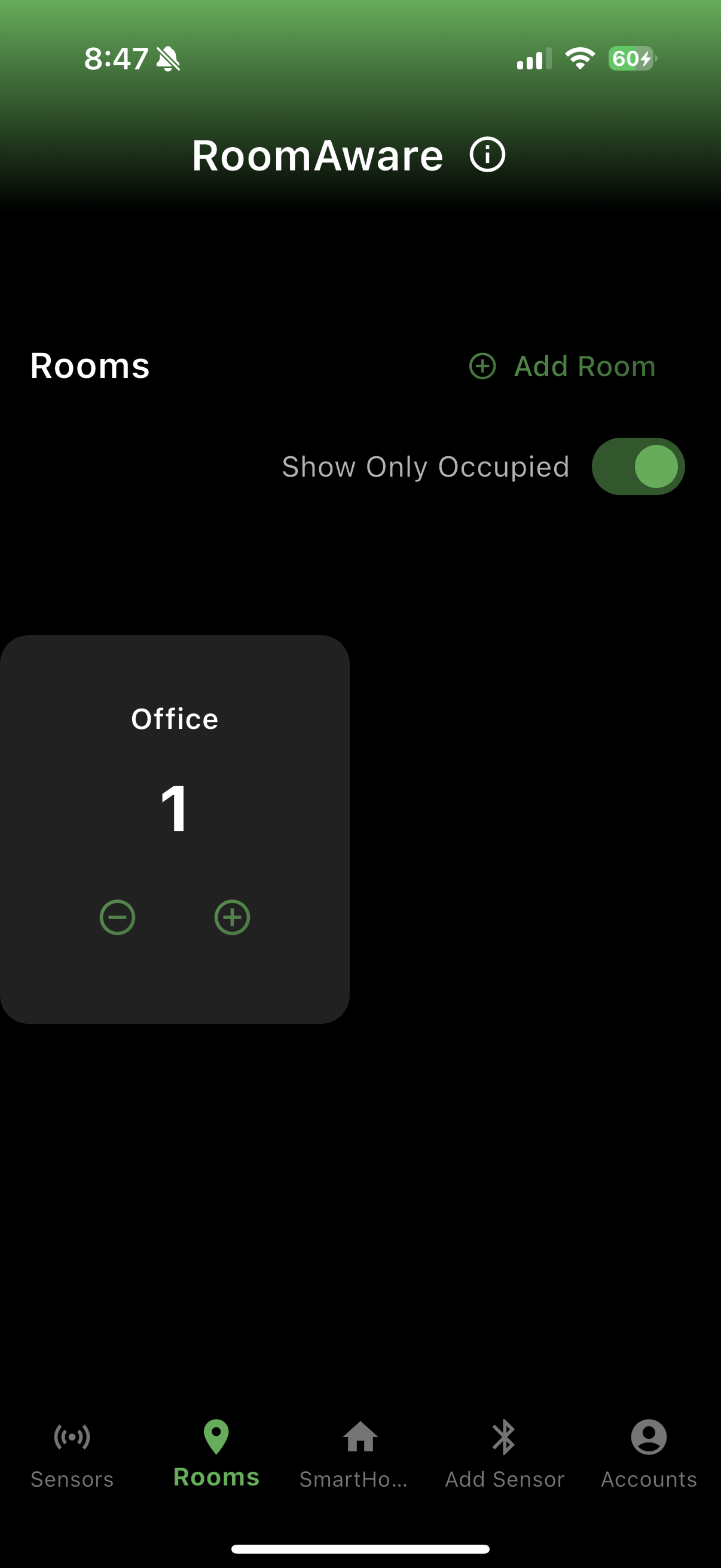Let’s geek out
RoomAware uses a Time-of-Flight (ToF) sensor to measure the height of a doorway and detect changes when someone walks through. As someone passes beneath the sensor, it picks up variations in distance from the doorframe to the individual. By analyzing multiple zones in real time, RoomAware determines direction of movement and accurately tracks the number of people in each room. This approach won’t get fooled if you start to enter a room and back out or if you’re carrying something. It ensures 100% privacy and only needs to monitor your door ways where other solutions may require line of sight to your entire room. The device is 5v and runs off USB-c.
Using ToF gives some benefits over mmWave or PIR. Without constantly monitoring the entire room the sensor can keep track of number of occupants. This also gives some unique customizations:
Ignore Zone (Figure 2) is a configurable value useful for excluding children, pets (ie: lions because tinkercad doesn’t have a cat rendering), or robot vacuums from occupancy counts.
RoomAware is door-friendly: it won’t mistake a swinging door for a person. And in the rare case it misses an entry or exit, you can easily correct the room count through the RoomAware app.
With Room Prep Zones (Figure 3), you decide exactly when automation should kick in. Want the lights on the moment you begin entering? Choose Zone 1 for instant activation and a seamless transition. Prefer a slight delay to avoid triggering the lights during a quick pass-by? Select a higher zone to prep the room only once you're fully inside.
RoomAware has many features that were missing in other solutions, but it’s important we don’t over promise and under deliver. In order to sell this product we need your help. Please visit how to buy for more details.
Figure 2:
Figure 3:
Figure 1:
Designed for your smart home
RoomAware is Cloud Optimized, never Cloud Required. This is an important principal to ensure you own the device you bought. If you want to access your data over the internet, that is your choice.
HomeAssistant comes preinstalled on the Hub allowing you to integrate with any smart device you own. This is all behind the scenes and doesn’t require the average user to know anything about Home Assistant.
APIs are accessible for any further development you wish to implement.
Automation rules can be configured in the API layer directly through the app.
-
Lets say you want to turn on the lights when you enter an empty room, but if someone is already in there sleeping you don’t want to wake them up. RoomAware lets you turn on the lights if you’re the only person in the room and turn on a night light if somebody else is in there. This is just one example of countless new home automations that will delight you and others in your home.
-
RoomAware accounts for that behavior. If you begin to enter a room the automation will start prepping the room for you, but if you change your mind and leave, everything will be undone. The room count won’t actually adjust until you are fully in the room.
-
Absolutely! A key principle of RoomAware is to show other companies that you can be successful without pushing a cloud first agenda. Cloud can enable capabilities, but some companies are making it a requirement and that could lead to ewaste which is bad for the planet and customers. RoomAware is built for tech enthusiasts by a tech enthusiast!
-
I’m running this in my home with a 99% accuracy. In the one out of a hundred chance that it misses a reading I adjust the room count on the app. I will enable voice assistant integration so you can do it that way as well.
-
In the future you will be able to daisy chain RoomAware sensors together allowing for large openings to be monitored as well.
-
Yes! RoomAware can be used for some rooms. When you install a sensor you select which rooms it’s between. You can select ‘Unmonitored Room’ if you don’t wish to fully cover another room.
-
mmWave has some interesting use cases, however I ran into a few limitations: 1) They typically only know if a room has people in it, not how many people 2) There can be lag in triggering automation when you walk into a room 3) The sensors can require tuning so you don’t have false positives and 4) Many sensors require line of sight to your entire room.
-
Yes, you will just need a sensor on each door.
-
RoomAware measures 16 zones many times per second so it can see which way somebody is moving.
-
That is up to you. If you want your pets or children to be detected then you can allow for that. Otherwise use the ignore zone and set a height taller than they are.
-
You would compromise privacy and that is a foundational component of RoomAware. I have these in my bedroom, bathroom, and children’s rooms. There is no risk to privacy with this solution. Other reasons cameras are sub par is because they would require significant processing power and the ability to see the entire room.
-
We don’t want to disappoint anyone who is purchasing this product so I need to ensure there will be enough demand. First I’m raising interest on social media. Once RoomAware has 2,000 followers a kick starter will be launched and if we hit the target sales it will ensure we have proper support, a printed PCB, and casing mold. If you want RoomAware, please follow on socials and help spread the word.











